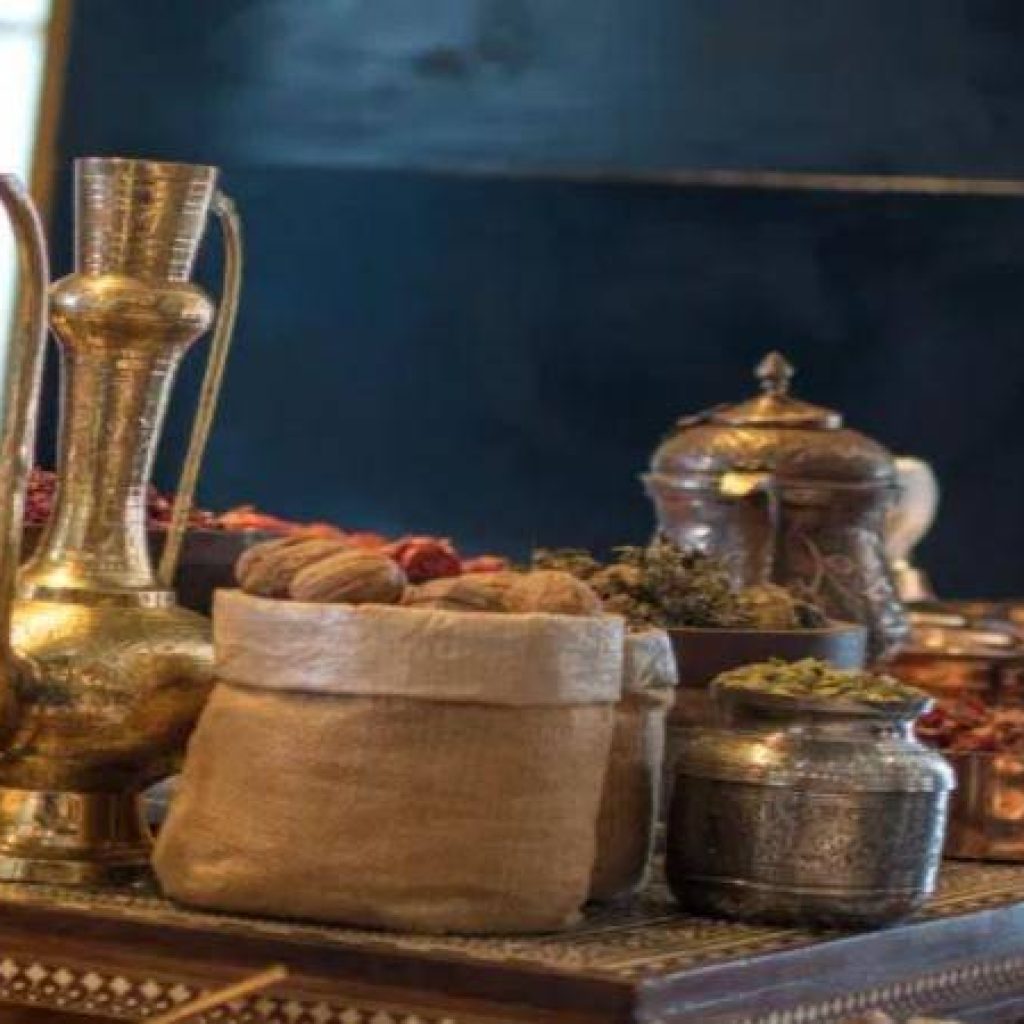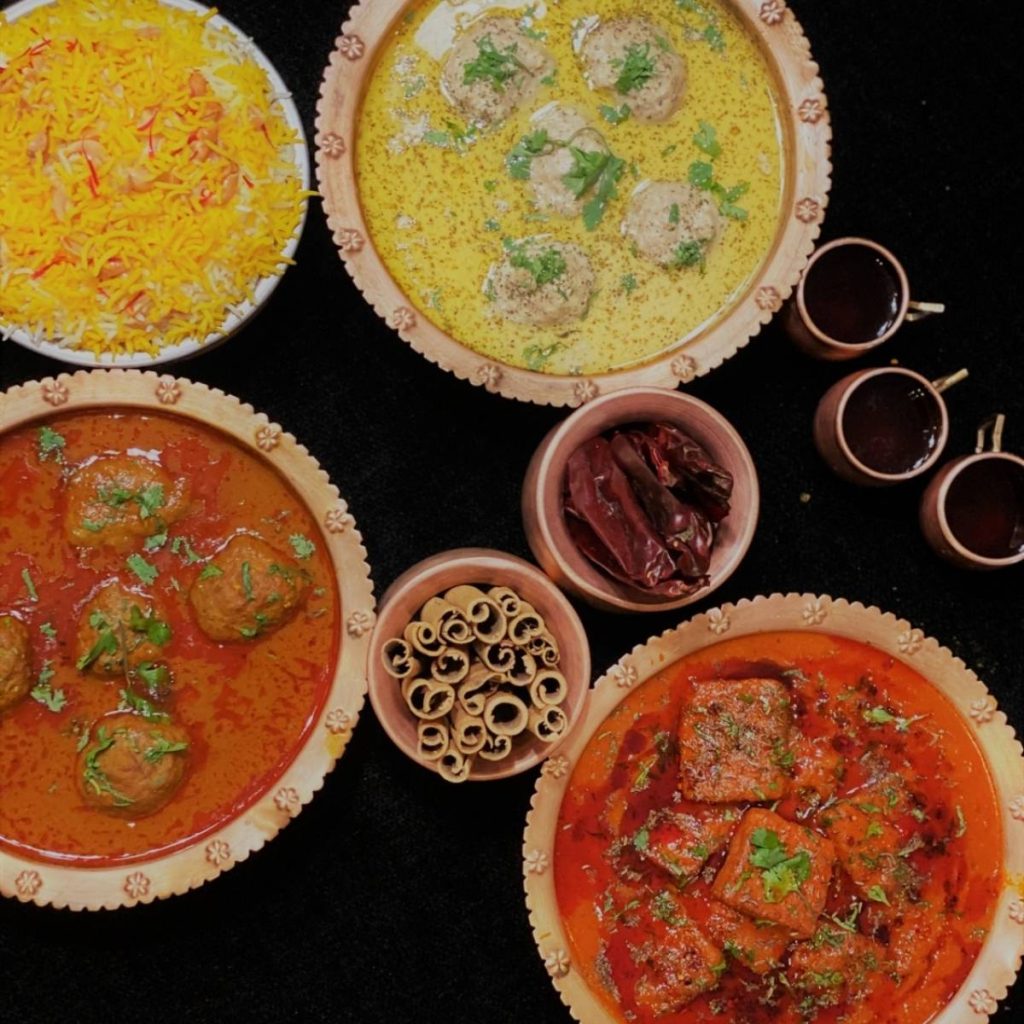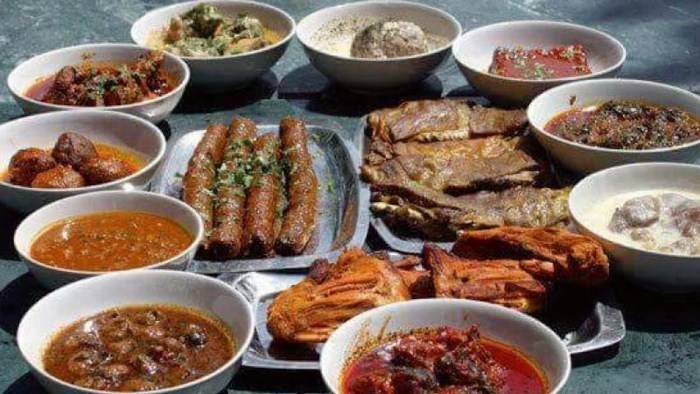All dishes are eaten by hand as Kashmiris believe in an intimate relationship with food. One would barely have eaten the mutton that the next sequence of dishes would be presented…reports Asian Lite News.
When one talks about Hindustani cuisine, Wazwan scores the top position. The ’36-dish multi-course meal’ is not meant to satiate your hunger but to indulge you in an out-of-the-world experience.
The Wazwan is not just the learned ancestral knowledge, but the pride of the Valley; it’s a celebration and an emotion. ‘Waza’ literally means cook and ‘Wan’ means shop; ‘Wazwan’ means setting up a feast in the host’s courtyard.
Once upon a time, Kashmir was the centre of the Silk Route connecting Asia to the Mediterranean. The silk merchants used to pass this land for business and that’s how Kashmir was introduced to Persian and Russian flavours. In 1398 when Taimoor invaded Hindustan, he brought with him cooks (Waza) from the land of Samarkand (Uzbekistan). And these Wazas amalgamated the Persian, Turkish and Afghan techniques to develop the Kashmiri cuisine.
Wazas are obsessive and passionate artistes. The preparation of the meal begins long before sunrise — at 3 am. The Wasta Waza (Master Chef) supervises all other Wazas. The authentic Wazwan is made only of sheep meat – and different dishes require meat from different organs. Meat is prepared to be cooked within one hour of the butchering to maintain taste. It is minced with a walnut wood hammer on stone until it loses its stringiness. Wazas beat the meat till all nerves of the mutton are entirely dissolved for a creamy consistency.
Unlike most dishes of the Indian subcontinent where the flavour is added to the food while cooking on the flames, the Wazwan flavours are added while the dish is still uncooked – by adding flavoured water to the preparation or soaking the preparation in flavoured water (osmosis), or by exposing the preparation to flavoured smoke.
The flavouring blends are based not on spices but on mild herbs and flower essences. The red dye in food is from flowers like Cockscomb, called Mawal locally. The pre-cooking methods require a great deal of precision, culinary art, patience, and enormous love that Wazas liberally shower on their creations.
The food is cooked on old fruit tree logs using special nickel-plated copper vessels. The meat is boiled in salted water and this water is further used as broth for all the dishes. Kashmiri shallots (wild onion with a slight tinge of garlic, called Praan) and dried Kashmiri whole chilly are the souls of Wazwan.
As Wazwan is an experience, the ‘tehzeeb’ (mannerism and way) of eating the food is thorough. The Dastarkhwan (dining space) is arranged with spotless white sheets spread on silky Kashmiri carpets. The guests sit around the sheet in groups of four (Kashmiris eat food in small groups on the same plate). An attendant carries an hourglass-shaped ornamental copper pot called Tasht-e-Naer, which contains lukewarm water for washing hands and collecting the wastewater from guest to guest.
Then large, heavily engraved copper plates, called Tream, containing the first dishes of the Wazwan sequence — Rice, Mayth-Maz (chopped intestines), Seekh Kebab, Tabaq-Maz (ribs), and chicken — are placed before the guests. A Sarposh (copper lid) covers the tream, lest the food gets cold. The eldest family member says the prayer and the customary ‘Bismillah’ before beginning the meal.

All dishes are eaten by hand as Kashmiris believe in an intimate relationship with food. One would barely have eaten the mutton that the next sequence of dishes would be presented. This process continues till 21 different mutton dishes are served. Kashmiris consider it disrespectful if one refuses food varieties or an extra helping. They can go to great lengths to persuade you, like swearing to die if you refuse an extra serving!
And easily 2 kg of mutton and chicken are served per person, without including the rice, chutneys and curd! The order of the food served is such that the chef tries to make space for more food. For example, between two heavy mutton dishes radish chutney is served to increase appetite and quickly digest the previous dishes. And it is pertinent to mention that it is easier for Kashmiris to digest all the meat because of the strong mineral content of the Calley’s water which helps in faster break-down of food.
Kashmiris are very, very particular about the taste of dishes. Food connoisseurs can easily taste a single morsel and name the Waza who cooked it. And this is why Wazas are booked months in advance for ceremonies. Some people fix their marriages according to the availability of the desired Waza!

Here are some of the tempting Wazwan dishes:
* Methi Maaz – Minced sheep Tripe Curry flavoured with Methi (fenugreek leaves, the first dish set in Tream).
* Daniwal Korma – Mutton Korma cooked in coriander and Ghee with yogurt-based gravy.
* Sabz Haakh – Spinach-like leafy greens cooked in mustard oil with chilly, without which Wazwan is incomplete.
* Rogan Josh – Shoulder meat cooked in Praan paste, mawal flower essence, curd, and Kashmiri mirchi diluted essence. Rogan means fat and Josh means to cook on high heat.
* Goshtaba – Meatballs with cheesecake-like texture minced with fat and dipped in mutton broth, with gravy based on curd, cardamom, dry ginger, and fennel.
* Marchwagun Korma – Fiery hot Kashmiri chilly korma; three-quarters of the chilly used in the entire wazwan is singularly used in this dish!
* Doon Chetin – Walnut chutney flavored with yogurt and Kashmiri chilies – a Kashmiri staple that will take your breath away, literally!
* Masheid Al Chetin – Chutney made from pumpkin, dates, cardamoms, dried nuts and honey – to bring solace to your fired taste buds!
* Kashmiri Pulao – Basmati chawal cooked in milk and ghee with saffron and dry fruits and kishmish separately roasted in ghee.
* Tabakh Maaz – Glossy ribs cooked in ghee then simmered in yogurt till dry.
* Aab Gosht – Mildly flavoured sheep ribs cooked in milk gravy with cardamoms and saffron.
Amir Khusrow rightly said (perhaps, after this meal), “Gar firdaus bar rue zameen ast/hameen asto, hameen asto, hameen ast (If ever there is Paradise on Earth/It is here! It is here! It is here!).”
ALSO READ-‘Food preferences and concerns give chance to be more creative’

Leave a Reply